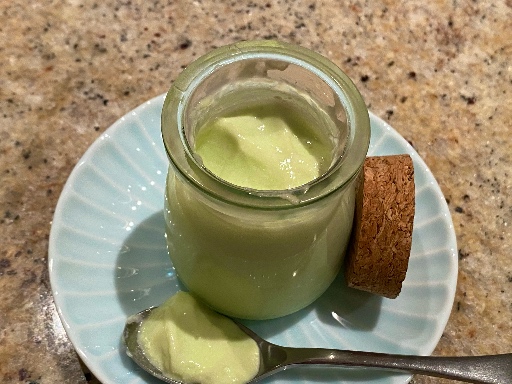When we
barbecue chicken in the Weber grill, we usually cook two birds since the effort to add another chicken is minimal once the Weber is set up. We eat only a small fraction of the two birds on the day we cook them. We removed the meat and use it for other dishes such as the sandwiches we take to work. I also use the cooked chicken in small dishes such as
chicken with sesame sauce or chicken
quesadilla. The easiest way to use up the cooked chicken meat before it goes bad is in
chicken noodle soup. I wanted to come up with some other dishes I could make using the cooked chicken. I was thinking of making some kind of terrine and came across
this recipe on the Web. The original recipe uses uncooked chicken breast to start but I modified it to use our cooked chicken.
The image below is the "remake" of my first attempt. I missed one sentence in the recipe "
Terrine will be quite fragile: If slicing, use an electric knife; otherwise, serve with a spoon". The first terrine (see picture below, the second from the bottom) was so fragile and I could not slice it using a regular (very sharp I might add) knife.
After the remake, I could slice it and present it on the plate. I served it with fresh cilantro and the sauce (hoisin and rice vinegar) (below).

I served this with soba noodles which was suggested in the original recipe. I did not think the hoisin sauce would be suitable for soba so I served the usual dipping sauce with the addition of nori and scallion.

Come to think of it, we have not eaten soba for some time. But in hot summer this is a good especially in combination with the chilled and jellied chicken terrine.

This was a cold plate lunch on another day. I served this terrine with my
potato salad, grilled corn and black bean salad, bulgur wheat salad and
Montparnasse cauliflower.

I made some modifications the the original recipe especially since the chicken meat I used was already cooked.
3 cups chicken broth, fat skimmed (I used low fat low salt Swanson chicken broth).
1/2 cup medium-dry Sherry (I used half and half of sake and mirin, instead)
2 teaspoons soy sauce (I used light colored soy sauce to keep jell light in color)
1 1/2-inch piece fresh ginger root, cut into 1/4-inch-thick slices
6 scallions, each cut crosswise into thirds and flattened with the flat side of a large knife
1 1/2 tablespoons star anise pieces, crushed lightly
1/2 teaspoon salt
1 pound skinless boneless chicken breasts*(about 3 breast halves) (I used both white and dark meat from barbecued chicken, hand shredded about 2 cups).
1 envelope plus 1 1/2 teaspoons (about 4 1/2 teaspoons total) unflavored gelatin (I added one more package when I remade the terrine).
1/2 cup fresh cilantro leaves, washed well and spun dry
*If using uncooked chicken, porch in the broth for 15 minutes and after removing the chicken, add water to make the amount of the liquid to 3 cups.
For sauce
2 tablespoons hoisin sauce
4 teaspoons rice vinegar (not seasoned)
I put the chicken broth in a pan with sake, mirin, ginger root, scallion, star anise, and light colored soy sauce (I did not add the salt). I simmered it for 25 minutes, strained and removed the solids and returned the broth in to the pan and added shredded chicken (both breast and dark meat). After 15 minutes of simmering, I separated the meat and broth using a sieve. I tossed the chicken meat with cilantro leaves and placed it in a terrine as seen below.

Meanwhile, I sprinkled the gelatin powder in 1/4 cup of water and let it bloom. I put the broth back in the same pan on simmer and whisked in the bloomed gelatin. when the gelatin melted completely, I cut the flame and poured the mixture over the chicken meat and cilantro. After the mixture came to room temperature, I moved it to the fridge and let it cool over night. I un-molded the terrine (by soaking the bottom of the pan in hot tap water for a few seconds). It looked nice as seen below. But it was too fragile to slice. We ended up tasting (as the original recipe suggested) using a spoon. It was remarkably good. The star anise and cilantro and soy sauce all went together.

The next day, I remade this terrine. I placed the jelled terrine in a pan and warmed it until the gelatin melted. I then removed the chicken meat with a tong and placed it in the loaf pan. I bloomed an additional package of unflavored gelatin in 1/4 cup of cold water. I whisked in the bloomed gelatin and after it melt completely, I poured it over the chicken meat. This time, all the chicken pieces were coated with gelatin-broth mixture and the additional gelatin made the terrine firmer. After over night refrigeration, the terrine was formed (below).

This time, the terrine was firm enough and the all chicken pieces were coated with the gelatin-broth. I could slice it nicely without tearing the entire thing apart. The hoisin sauce and rice vinegar combination made a nice sauce which complimented the flavor of the jellied chicken terrine very well. The addition of fresh cilantro added fresh flavor. This is rather delicate "Asian" flavored chicken terrine.










.jpeg)












